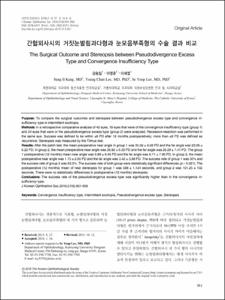간헐외사시의 거짓눈벌림과다형과 눈모음부족형의 수술 결과 비교
- Keimyung Author(s)
- Lee, Se Youp
- Department
- Dept. of Ophthalmology (안과학)
- Journal Title
- 대한안과학회지
- Issued Date
- 2016
- Volume
- 57
- Issue
- 6
- Keyword
- Convergence insufficiency type; Intermittent exotropia; Pseudodivergence excess type; Stereopsis
- Abstract
- Purpose: To compare the surgical outcomes and stereopsis between pseudodivergence excess type and convergence insufficiency
type in intermittent exotropia.
Methods: In a retrospective comparative analysis of 42 eyes, 18 eyes that were of the convergence insufficiency type (group 1)
and 24 eyes that were or the pseudodivergence excess type (group 2) were analyzed. Recession-resection was performed in
the same eye. Success was defined to be within ±8 PD after 12 months postoperatively; more than ±8 PD was defined as
recurrence. Stereopsis was measured by the Titmus test.
Results: After the patch test, the mean preoperative near angle in group 1 was 35.56 ± 6.62 PD and the far angle was 23.06 ±
6.22 PD. In group 2, the mean preoperative near angle was 26.92 ± 6.30 PD and the far angle was 28.29 ± 7.41 PD. The group
1 postoperative (12 months) mean near angle was 6.89 ± 8.46 PD and the far angle was 6.11 ± 7.90 PD. In group 2, the mean
postoperative near angle was 1.75 ± 2.85 PD and the far angle was 3.42 ± 3.98 PD. The success rate of group 1 was 50% and
the success rate of group 2 was 83.3%. The success rate of both group were statistically significant differences (p = 0.021). The
postoperative (12 months) mean of near stereopsis for group 1 was 588 ± 1,124 seconds, and group 2 was 101.25 ± 102
seconds. There were no statistically differences in postoperative (12 months) stereopsis.
Conclusions: The success rate of the pseudodivergence excess type was significantly higher than in the convergence insufficiency
type.
- Alternative Title
- The Surgical Outcome and Stereopsis between Pseudodivergence Excess
Type and Convergence Insufficiency Type
- Keimyung Author(s)(Kor)
- 이세엽
- Publisher
- School of Medicine
- Citation
- 강승일 et al. (2016). 간헐외사시의 거짓눈벌림과다형과 눈모음부족형의 수술 결과 비교. 대한안과학회지, 57(6), 951–956. doi: 10.3341/jkos.2016.57.6.951
- Type
- Article
- ISSN
- 0378-6471
- Appears in Collections:
- 1. School of Medicine (의과대학) > Dept. of Ophthalmology (안과학)
- 파일 목록
-
-
Download
 oak-2016-0268.pdf
기타 데이터 / 435.44 kB / Adobe PDF
oak-2016-0268.pdf
기타 데이터 / 435.44 kB / Adobe PDF
-
Items in Repository are protected by copyright, with all rights reserved, unless otherwise indicated.